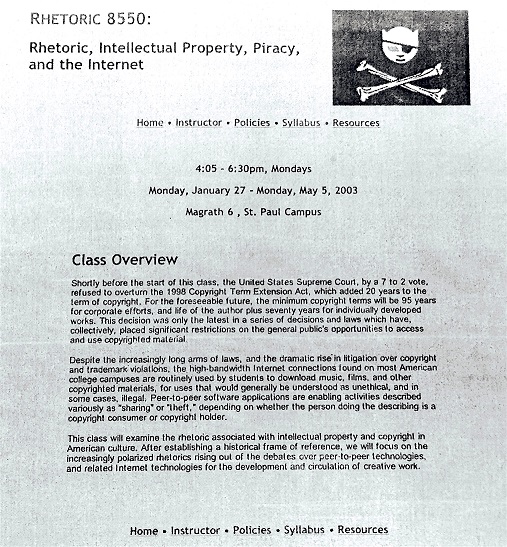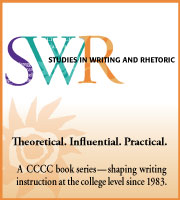Introduction to the 2015 CCCC-IP Annual
by Clancy Ratliff
I remember being in John Logie’s rhetoric and intellectual property seminar at the University of Minnesota in 2003.

From my personal archives: a photo of the course syllabus.
He would often ask us to find news stories about, to use his phrase, the IP landscape, and in class we would juxtapose our discussions of critical theory of authorship and complex analysis of copyright law with current news about intellectual property issues. This began a habit of mind for me, which after about a decade I have systematized: all through the year, I see interesting stories in my social media feeds and my other reading, and I paste those URLs into a TextEdit document (and I’m increasingly doing screen capturing to augment this), which I turn into a CFP around the end of each year – a wish list of topics I hope people will want to write about, and they do, and very well.
In the 2015 Caucus meeting, we decided to start including a dedicated pedagogy section in the Annual. All the articles have had connections to rhetoric and composition in some way, but the three articles in the Pedagogy section this year are more explicitly directed toward classroom application and reflections on teaching writing. Kristi Murray Costello’s excellent analysis of the FI (failure for cheating or plagiarism) course grade is the first scholarly examination in our field of this new institutional development. Steven Engel gives us several clever classroom activities about the misattributed quotation on the Maya Angelou postage stamp that help students better understand authorship. Kathrin Kottemann helps us reflect on what we’re asking students to do as authors; through her research about catfishing, an online dating phenomenon, she raises the question: are we asking our students to be catfish? To pretend to be someone else? In future years, we hope to have not only pieces such as these, but other teaching genres as well: syllabuses for new courses on IP issues, lesson plans, assignment descriptions, and curated lists of resources for teaching about copyright and authorship.
After the section of articles that are closely related to pedagogy is the section I’m calling Copyright and Authorship in Culture. The six articles in this section all look at 2015 events in the IP landscape and situate them in rhetoric and composition broadly. Matthew Teutsch illustrates the stakes of appropriation in his analysis of a political cartoon on Twitter that perhaps some of us saw: the lowering of the Confederate flag followed by the raising of the LGBT pride flag, a visual comment on two of the most important (and in one case, tragic) historical moments of the year. Craig A. Meyer writes about an artist who enlarged and printed Instagram photos of members of SuicideGirls, an adult lifestyle brand, as they describe themselves online. I will admit that I found the moving of the Instagram images across contexts to large gallery-quality prints to be an inventive and chic stylizing. However, the artist did not inform anyone in SuicideGirls that he intended to do this, and he sold the images for $90,000 each. Meyer’s analysis of this case is insightful.
William Duffy provides an impressively thorough explanation of the complexities and stakes of the “defeat devices” in Volkswagens: software that reported false data about emissions. Freedom to tinker in this case has implications for the environment, road safety, and much more. Wendy Warren Austin has taken the news story about the emergence of the kilo-author – which is exactly what it sounds like: 1000 or more co-authors – and made a substantial contribution to composition scholarship in her analysis of authorship in the sciences.
Laurie Cubbison continues her tracking of Taylor Swift’s copyright advocacy, which began in the last CCCC-IP Annual with a report about Swift’s decision to pull her album from Spotify. This year, Cubbison analyzes Swift’s argument to Apple: she pulled her album from the Apple Music streaming service because artists would not be paid for songs streamed during the free trial period for users, and Apple reacted by agreeing to pay the royalties. Kim Gainer reports on the most recent legal developments involving the status of the song “Happy Birthday,” a song that should have been in the public domain already but has not been. Now, however, those wanting to use “Happy Birthday” in audio or video compositions may do so without worry – though specific performances of the song may still be protected by copyright, of course.
The CCCC-IP Annual has always featured thoughtful and critical reviews of longer texts about copyright and intellectual property, particularly white papers from other organizations such as Creative Commons and the Electronic Frontier Foundation. Traci Zimmerman continues this tradition with a review of a new handbook from the Authors Alliance, Understanding Open Access: When, Why, & How to Make Your Work Openly Accessible.
In sum, I’ve learned a lot from reading this year’s Annual articles, and I hope you do too. If you assign any of them in your classes (they would work so well not only in composition classes, but in technical writing and literature courses also), please contact me and let me know how it went.












